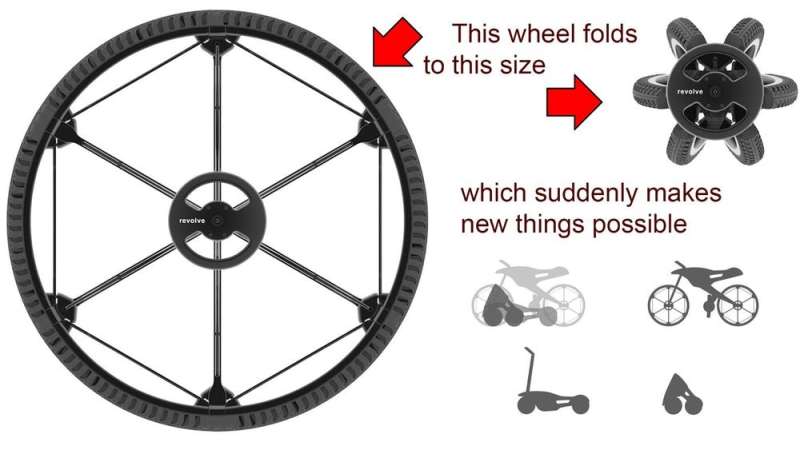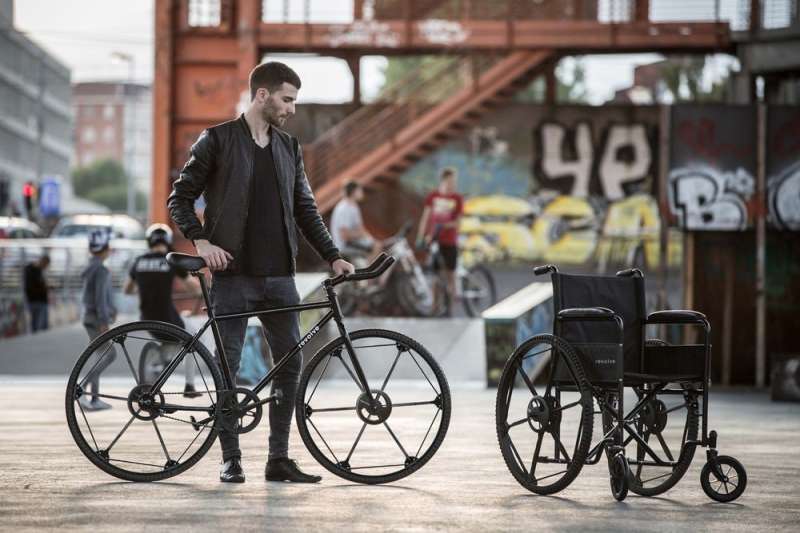January 19, 2018 weblog
The wheel according to inventor Mocellin: Good-looking, efficient, folded

Inventor Andrea Mocellin is posting a video earlier this month that reflects his desire to spur interest in his multi-year effort to get something right: A foldable wheel with design to make a difference in how people can lead travel-efficient lives.
With Revolve you carry the wheel places, crossing over easily between your trains, planes and automobiles. With a simple action, you open and close the wheel.
He designed the wheel as foldable. He said it can be folded such that it occupies up to 60 percent less space. Two handles lock and unlock the wheel. Consider its implications too. Not only does the owner have more room in a modest sized apartment to accommodate a bicycle but bicycle stands could also have the advantage of added space.
Also, as for wheelchair wheels, Brian Wang in Nextbigfuture commented that "Having lighter and stronger wheelchairs will be a huge benefit to the aging and disabled."
This is a full-size 26-inch spoked wheel. Size matters. Mike Hanlon in New Atlas explained:
"The problem which Mocellin's wheel overcomes, is that folding bicycles until now have had to use smaller wheels to be able to fold to a small enough size for carrying – most folding bike manufacturers use 16- or 20-inch wheels. The Revolve can offer full size 26-inch wheels that fold to less than one third their height."
Wang had some design details of the wheel that can be collapsed: The wheel has a double hub, rim with rubberized sectors, and "spokes pivotly connecting each hub with the sectors of the rim."
Wang said that spokes "are pivoted to the hubs substantially on the wheel axis and in the collapsed condition the sectors of the rim extend longitudinally between the two hubs."
Mocellin told New Atlas that "The patented design was reached after several hundred 3D models and dozens of physical prototypes as I attempted to get the most accurate and efficient folding mechanism."
There is a back story as to why designing a folding wheel captured his interest. Mocellin was a traveler, having lived in several cities in Europe, in Shanghai and in New York—having commuted on trains, roadways and bike paths—often on the go with a folding bicycle. "I have experienced so many folding bicycles with small wheels that are complicated and ugly when they are closed," he said in New Atlas.
At the same time, though, the inventor's vision goes beyond bicycles and wheelchairs. Foldable vehicle? Cart? Land drone? Hand luggage?
New Atlas quoted him saying "It was conceived as an enabling technology, and when folded, the side wheels that can be added as either traditional wheels or omnidirectional wheels are also designed to enable new ways of making better folding vehicles that can be used and transported in different ways."
This full-sized wheel collapses to just 8 inches when folded, said Daily Mail.

More information: www.revolve-wheel.com/
© 2018 Tech Xplore




















